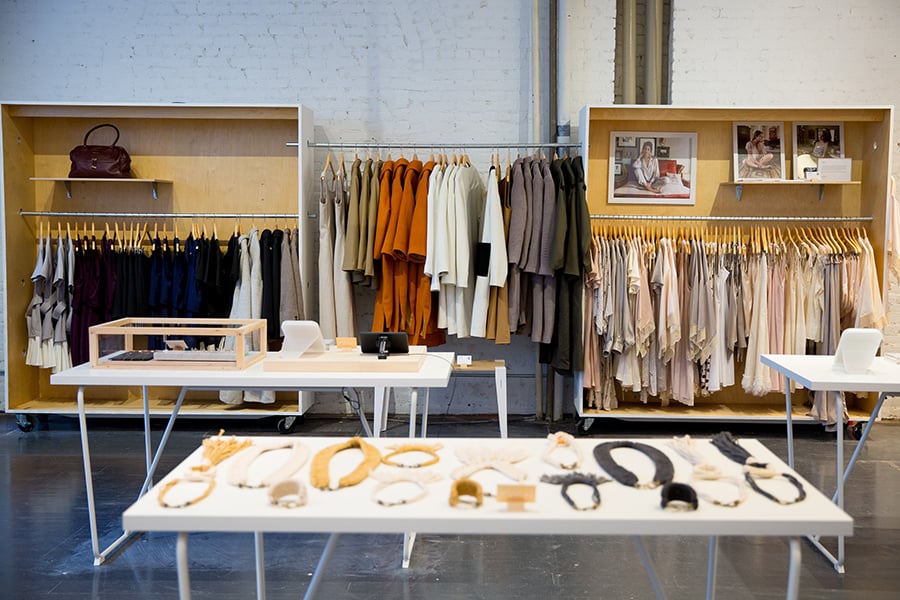
October 12, 2017
Good Goods Wants to Change How Designers (and Retailers) Do Business
The New York–based company just opened its first Soho pop-up store, which will stay open through January.

“I don’t think you can fight Amazon,” admits Eric Ho, co-founder of Good Goods, an independent retailer that just opened a physical store in New York’s Soho neighborhood.
You could be forgiven for thinking Good Goods’ new store is a fool’s errand: E-commerce is reshaping traditional brick-and-mortar retail, causing layoffs and store closings across the U.S. Retailers are scrambling to stay competitive as Amazon leverages economies of scale, ever-vigilant advertising algorithms, and even cashier-less stores. But Ho and fellow Good Goods cofounder Rosa Ng see an opportunity, one that involves helping smaller designers and makers. “Even though e-commerce is going to increasingly dominate our lives,” says Ho, “there’s still a need for physical retail. The future is not about physical versus digital, it’s about how you create more touch points for everyone.”
Good Goods–part collective, part pop-up–is Ho and Ng’s brainchild. The former, who was a practicing architect, started a company called miLES that activates vacant and underused storefronts in the Lower East Side with retail, education, and even food-related programming. Ng, meanwhile, comes from a fashion background and started a business to help other designers sell and market their wares. After crossing paths and discussing the challenges of retail, they resolved to do something about it: they started planning Good Goods this February 2017 and launched just two months later.

In addition to the broader disruptions rocking the retail industry, Good Goods’ clientele of small designers face special challenges: they have limited time, money, and expertise to market their wares and build brand awareness. Pop-ups, while popular, can be a huge drain, from negotiating with landlords to the physical set-up and break-down. “For them, it’s all about design. That’s what they’re focusing on. It’s hard for them to have the cash flow to do anything else,” says Ng.

The Good Goods model is straightforward: Ho and Ng have located a short-term lease in a prime Soho location (121 Prince St.) and stocked it with a wide array of wares from small designers and makers: everything from coffee and jewelry to pottery and clothing. “When we designed the shop, we know it was going to be very lifestyle, so [there’s] a little bit of everything so people spend time here, shop through it,” says Ng. Good Goods had an open application process, though the cofounders proactively contacted potential applicants to build a diverse selection of brands and products. “The baseline is that we need it to be quality design,” says Ho, though this can mean design that’s socially driven, eco-friendly, or locally made. (For example, the clothing company New Market Goods aims to support support Bangladeshi communities and craftsmanship while Little Seed Farm produces chemical-free, sustainable soap.)

If accepted, the admitted designers–who have typically been in business two years and are looking for additional sales channels–pay a membership fee based on the price point of their wares, as well as the space required to display them. Good Goods also receives a small commission on every purchase. “We share the risk of going into a space together, like crowdfunding,” said Ho. “You’re going into the space together, as a collective of fifty of so, possibly more.”
Good Goods isn’t just about moving stock, though. Each physical display includes a QR code that leads to the designer’s profile on Good Goods’ website. (Android users can just physically tap the label, which uses NFC cards to seamlessly open the profile on the smartphone’s browser.) “We really want our online presence to be more about storytelling,” says Ng, who adds that the Good Goods profiles link to the designer’s websites where users can make purchases.

Ho and Ng also recently received some major support for their experiment: Good Goods was admitted to URBAN-X, the urban-focused business accelerator run by the car company MINI. Their co-retail model could “disrupt” how retail works in cities, something “that really aligns with what URBAN-X’s mission…of looking at urban life in a different way,” says Ho. The accelerator is working with Good Goods to track and analyze activity in their story; the goal is to understand “what engagement really means in a real, quantifiable way. Those are hard questions…. Does it mean touching a product, lifting it and putting it back, how we do we track that? Make sense of that?” New sensor technologies make that possible (see: Amazon Go). “[These] are things all the big retailers are trying to figure out,” adds Ng.
What’s next for Good Goods once January rolls around and its lease is up? Ho and Ng are free to experiment: “Let’s say there’s going to be a low season, how do we leverage that to do something that’s more creative or disruptive?”
You may also enjoy “How New York Designers Like Fernando Mastrangelo Are Cutting Out Gallery Middlemen.”





